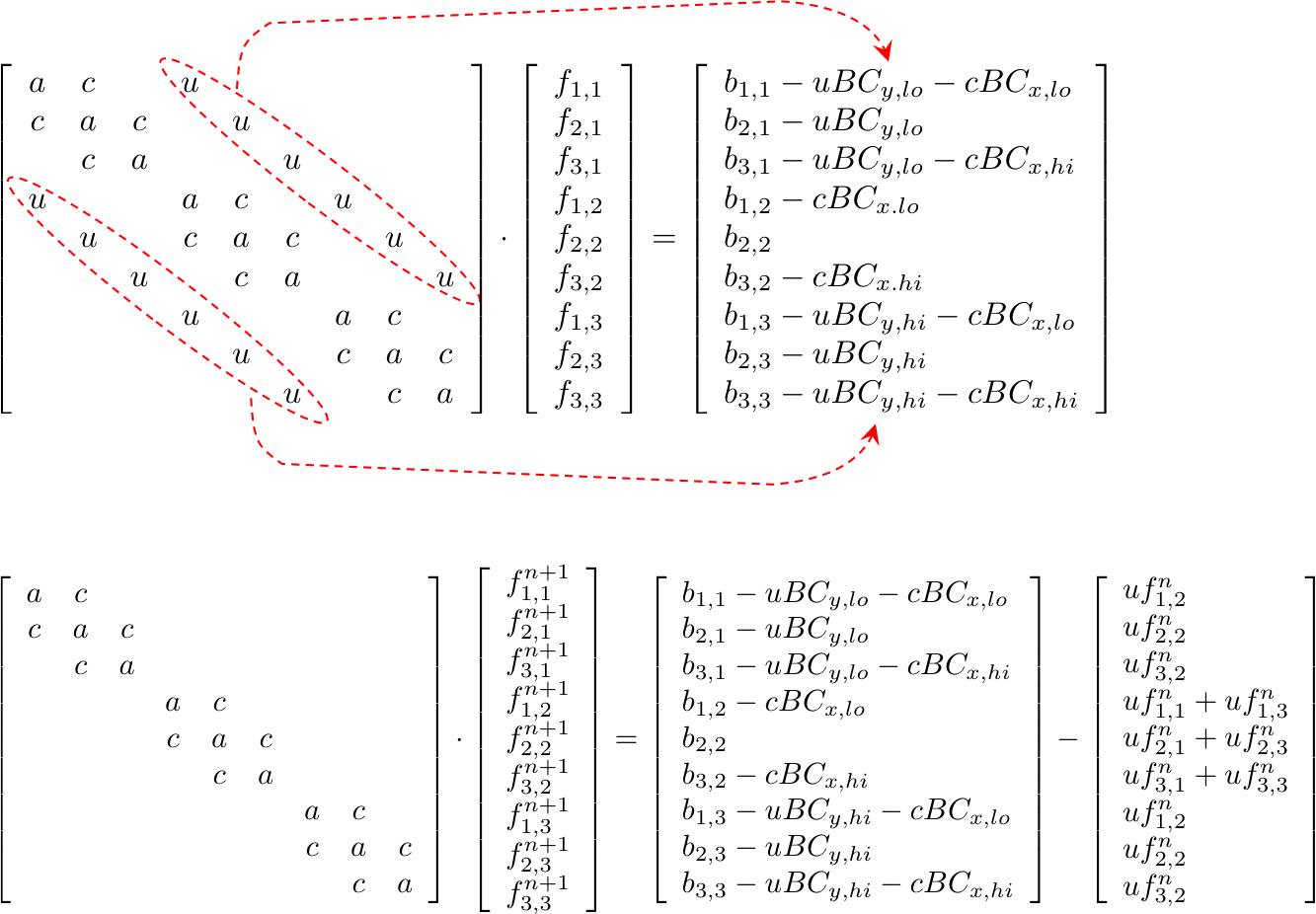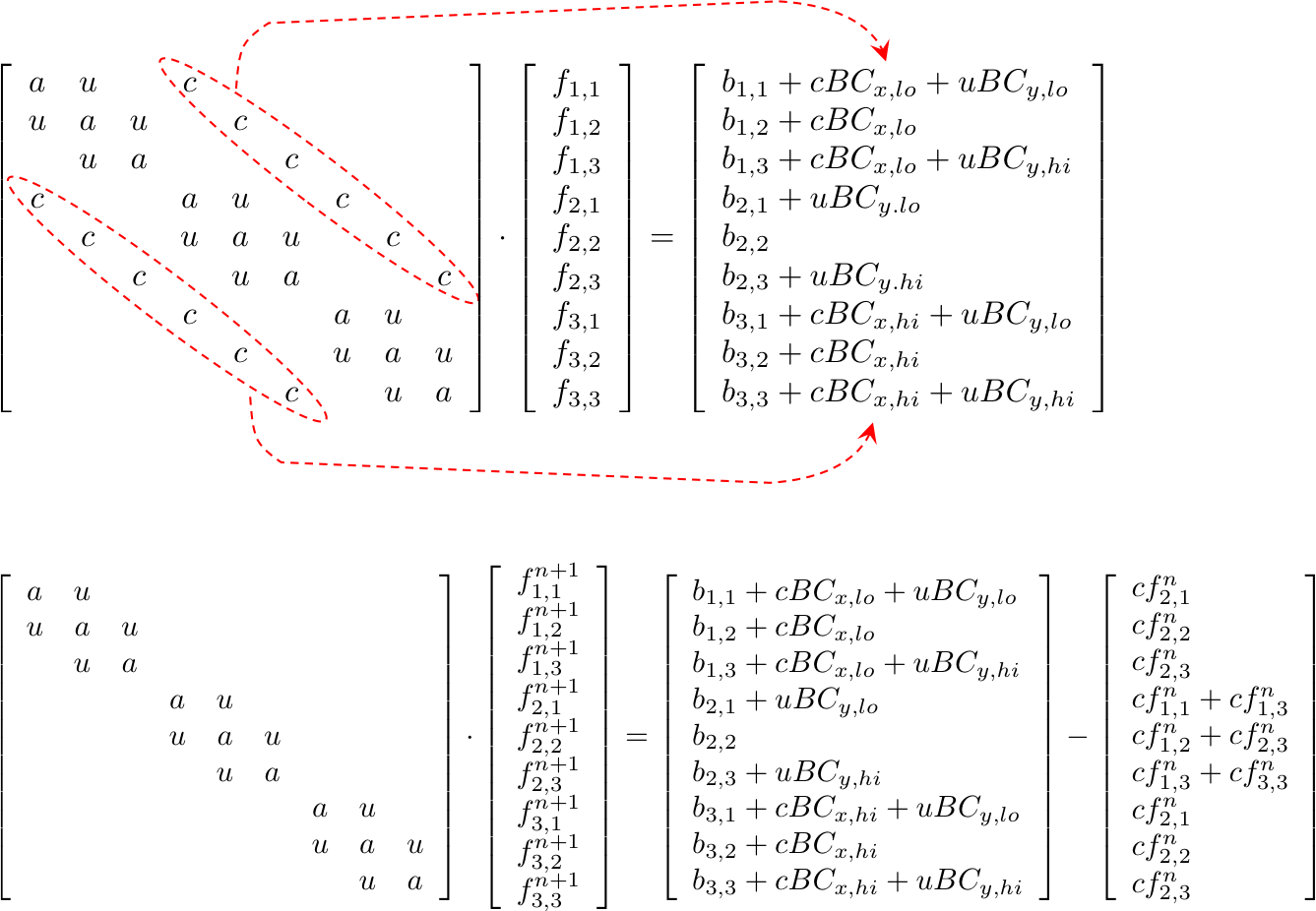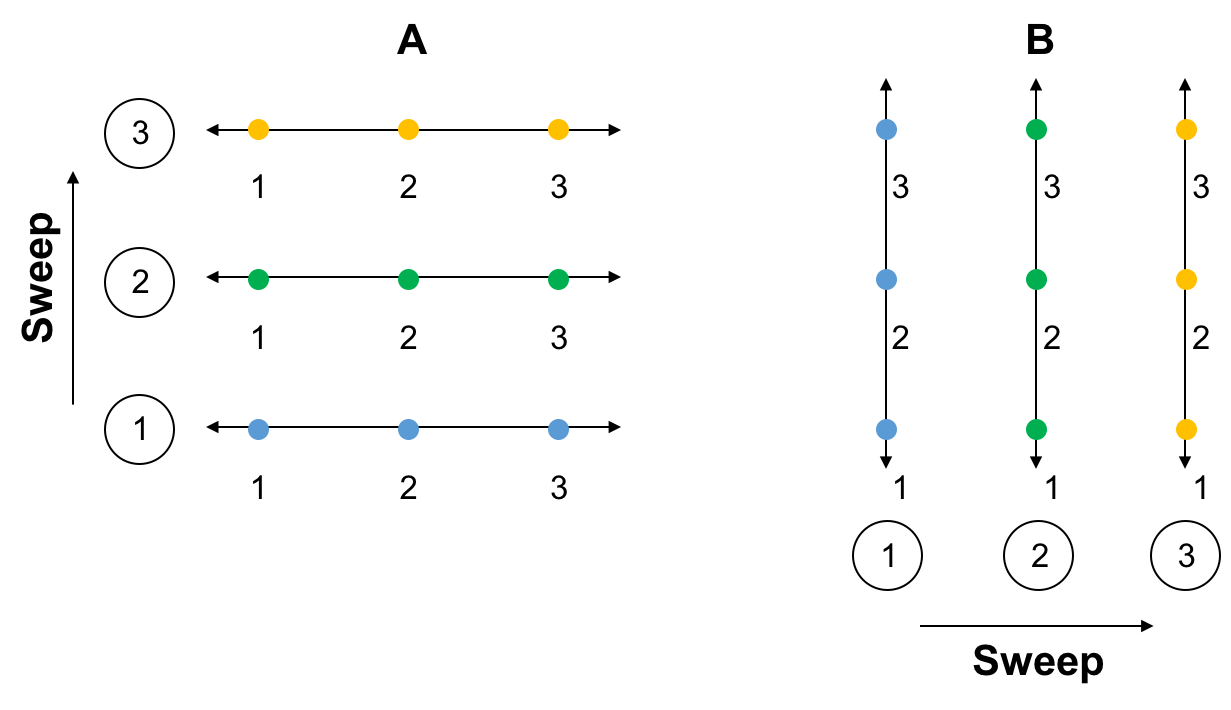- Previously, the two dimensional, implicit parabolic PDE resulted in a penta-diagonal system of equations to solve at each point in time.
- A canonical elliptic equation is like a steady version of the parabolic equation:
$$\alpha\frac{\partial^2f}{\partial x^2} + \alpha\frac{\partial^2f}{\partial y^2} + S(x,y) = 0.$$
- Again, we define a two-dimensional grid and apply centered difference approximations to the derivatives.
$$\frac{\alpha}{\Delta x^2}(f_{i-1,j} - 2f_{i,j} + f_{i+1,j}) + \frac{\alpha}{\Delta y^2}(f_{i,j-1} - 2f_{i,j} + f_{i,j+1}) + S_{i,j} = 0.$$
This is written in coefficient form as
$$uf_{i,j-1} + cf_{i-1,j} + af_{i,j} + cf_{i+1,j} + uf_{i,j+1} = b_{i,j}.$$
- When ordering the grid sequentially from left to right and top to bottom we obtain a penta-diagonal system of linear equations to solve.
Linear solution
- Direct methods:
- This system could be solved with a purpose-built direct solver like an extention of the Thomas Algorithm.
- Iterative methods:
- More common
- Start with an initial guess of the solution, and iterate to convergence.
- Jacobi, Gauss-Seidel, SOR
- Conjugate Gradient method
- Multigrid methods
- Alternating direction implicit (ADI) method.
Alternating Direction Implicit (ADI)
- The Thomas Algorithm was fast and easy to implement.
- ADI is an iterative method, not unlike Gauss-Seidel, that arranges the unknowns in such a way that the system is tridagonal at each iteration step.
- There are two approaches
ADI 1
-
Order the grid in two ways (A), and (B) (boundary points not shown):

-
These 3x3 grids (9 unknowns) will result in 9x9 matrices.
-
Grid (A), for any given point, the top and bottom neighbors are on diagonals $\pm n_x$
- Tridaigonal with $\pm j$ on off-diagonals $\pm n_x$
- In each equation move $y$-directed neighbors to the RHS of the equation and use previous values to evaluate them.

-
Grid (B), for any given point, the left and right neighbors are on diagonals $\pm n_y$.
- Tridaigonal with $\pm i$ on off-diagonals $\pm n_y$.
- In each equation move $x$-directed neighbors to the RHS of the equation and use previous values to evaluate them.

- Alternate the grids. Each iteration solves Grid (A) then Grid (B). Iterate to convergence.
ADI 2
-
Instead of considering the whole 9x9 system, we treat the 2-D grid as a sequence of 1-D problems.
- We sweep the grid in the y-direction, then the x-direction.

- We sweep the grid in the y-direction, then the x-direction.
-
Grid A
- For line (1), we form a tridiagonal system with points (1), (2), and (3) as the unknowns.
- That is, points $f_{1,1}$, $f_{1,2}$, $f_{1,3}$ are the unknowns.
- All other points in the 2-D, 5-point stencil are considered known.
- This gives a 3x3 tridiagonal matrix for the grid shown.
- We solve this system and update the three points.
- Repeat this for line (2), then line (3).
- Note that we are coupling the x-direction points and decoupling the y-direction points.
- For line (1), we form a tridiagonal system with points (1), (2), and (3) as the unknowns.
-
Grid B
- Follow the same approach as in Grid A.
- But now, we are coupling the y-direction points and decoupling the x-direction points.
-
One iteration consists of sweeping lines (1), (2), and (3) on Grid A, followed by sweeping lines (1), (2), and (3) on Grid B.
-
Matricies are setup in the usual fashion, with decoupled points on the RHS, and boundary conditions properly specified.
Notes
-
ADI 1 is more matrix-centric
-
ADI 2 is more grid-centric
-
Note how these ADI methods fully couple one dimension at a time allowing full information propagation in the given direction.
-
The pentadiagonal solve only requires one iteration.
-
The Gauss-Seidel method decouples both directions, so information propagates more slowly across the domain.
-
The ADI is in-between.
-
In 3-D we have a heptadiagonal system with three grids.
- For ADI 1, we again move four of the seven off diagonals to the RHS, and alternate between the grid ordering.
- For ADI 2, we sweep lines in the x, y, and z directions sequentially.
-
Elliptic methods are very common, but often occur as parts of larger problems.
- In fluid mechanics, the pressure Poisson equation is an example.
-
All of this applies to implicit parabolic problems such as the BTCS and CN methods.
Hoffman version
-
For parabolic problems, Hoffman gives an ADI alternative.
- Rather than converge the ADI algorithm at each timestep, (since we have a $\Delta t$ truncation error anyway), we can solve as follows:
$$\frac{\color{blue}{f_{i,j}^{n+1}}-f_{i,j}^n}{\Delta t} = \alpha\color{blue}{\left(\frac{\partial^2f}{\partial x^2}\right){i,j}^{n+1} + } \alpha\left(\frac{\partial^2f}{\partial y^2}\right){i,j}^n + S_{i,j}^n,$$
$$\frac{\color{blue}{f_{i,j}^{n+2}}-f_{i,j}^{n+1}}{\Delta t} = \alpha\left(\frac{\partial^2f}{\partial x^2}\right){i,j}^{n+1} + \alpha\color{blue}{\left(\frac{\partial^2f}{\partial y^2}\right){i,j}^{n+2}} + S_{i,j}^{n+1}.$$
- On one timestep we implicitly couple the x-direction and the y-direction is decoupled (explicit).
- On the next timestep, we implicitly couple the y-direction and the x-direction is decoupled (explicit).